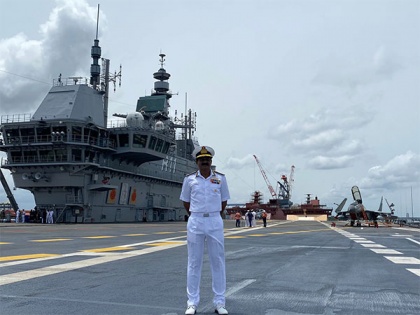Indian Navy requires three aircraft carriers: Vice admiral MA Hampiholi on Chinese threat in IOR
By ANI | Published: August 23, 2022 09:36 PM2022-08-23T21:36:42+5:302022-08-23T21:45:02+5:30
To deter Chinese presence in Indian Ocean Region, Southern Naval Command (SNC) Chief Vice admiral MA Hampiholi said Indian Navy requires three aircraft carriers and with carrier battle group (CBG) centered around Vikrant will provide unmatched flexibility and deterrence when the time comes calling to go for action.

Indian Navy requires three aircraft carriers: Vice admiral MA Hampiholi on Chinese threat in IOR
To deter Chinese presence in Indian Ocean Region, Southern Naval Command (SNC) Chief Vice admiral MA Hampiholi said Indian Navy requires three aircraft carriers and with carrier battle group (CBG) centered around Vikrant will provide unmatched flexibility and deterrence when the time comes calling to go for action.
"As per our own maritime capability perspective plan, which outlines the kind of capabilities and the force levels of the Indian Navy looking into the future after gauging the various threats. We have arrived at the fact that the Indian Navy requires three aircraft carriers which should mean that there will be one on each seaboard one on the west, one on the east and the third, if not available, would be of course in maintenance," Hampiholi told ANI.
He further added: "The carrier battle group (CBG) centered around Vikrant will provide Indian Navy unmatched flexibility, reach and sustenance and deterrence will provide for the accomplishment of all missions because of two very primary factors of a CBG that is the persistence of airpower in the midst of the oceans and beyond. And presence, which will provide both deterrence and of course, when the time comes calling to go in for action."
The addition of the Vikrant to the Indian Navy's fleet is a significant accomplishment for the Government's "Make In India" initiative, as 76 per cent of the content is indigenous, adding India to an elite group of nations with indigenous aircraft carriers (IAC).
Talking about future plans for Vikrant, Hampiholi expressed that the future plans often the commissioning of the ship would involve flight trials and integration of the most important element of the carrier and that is the combat aircraft. "So the ship will be proceeding for trials for integrating the combat element along with the deck element and proceed for trials and thereafter become a whole combat body ship," he said.
The Indigenous Aircraft Carrier would soon be commissioned into the Indian Navy as Indian Naval Ship (INS) Vikrant which would bolster India's position in the Indian Ocean Region (IOR) and its quest for a blue water Navy.
The ship would be capable of operating air wing consisting of 30 aircraft comprising of MIG-29K fighter jets, Kamov-31, MH-60R multi-role helicopters, in addition to indigenously manufactured Advanced Light Helicopters (ALH) and Light Combat Aircraft (LCA) (Navy).
Speaking about Vikrant being a perfect example of Atmanirbhar Bharat, the Vice admiral said: "If you see the USP of the Vikrant is the fact that it is 76 per cent indigenous. Firstly, as I said has been designed in-house by the Navy's warship design unit. And more importantly, it's been built by an ecosystem of Indian industry."
He revealed that more than 544 registered big and small Indian firms' industrial houses with the Cochin Shipyard Limited have contributed to making Vikrant.
"These include the big names like BEL, BHEL, L&T, Kirloskar, and so on and so forth. In addition, orders worth 292 crores were placed Over the last 10 years to about 100 MSMEs so about 76 per cent by cost of the Vikrant is indigenous which amounts to almost about 15,000 crores the cost of the ship is almost about 19,500 crores as per the study of the KPMG for every single employee who's employed at CSL it gives rise to employment to about 6.4 personnel in the ancillary industry. And with CSL employing almost about 2000 people it amounts to about employment generation to the tune of about 12,800 personnel down the line downstream in the ancillary units," Vice admiral said.
( With inputs from ANI )
Disclaimer: This post has been auto-published from an agency feed without any modifications to the text and has not been reviewed by an editor
Open in app